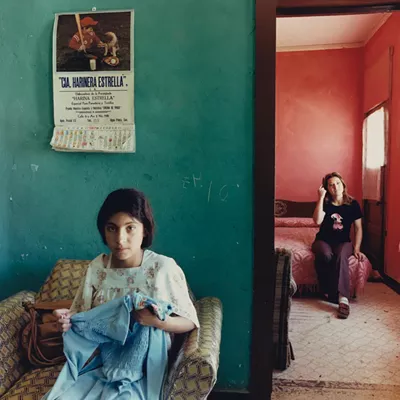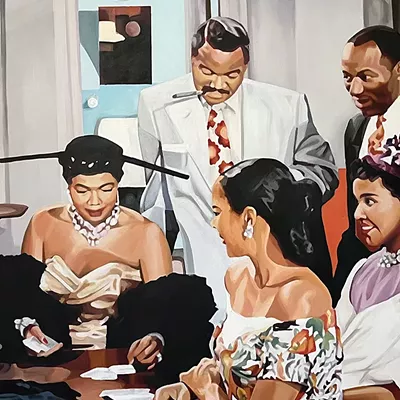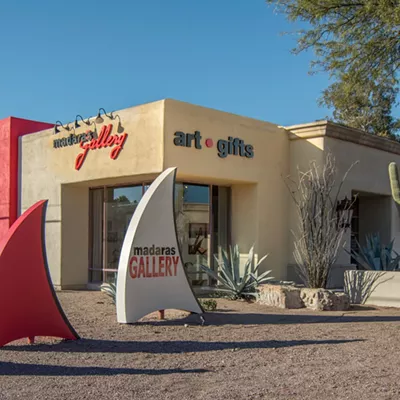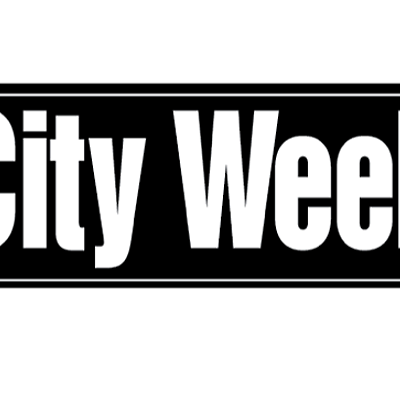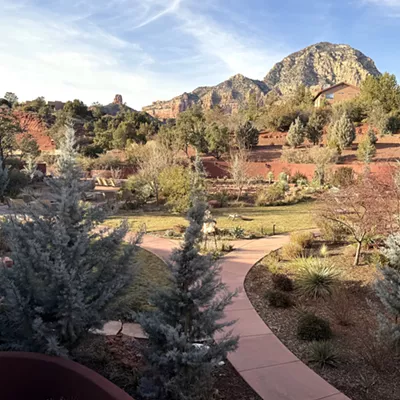The sun is already blazing at 7 a.m. as Valarie James sets out to walk the Marley, the big ranch across the road from her place west of Amado.
Her three dogs bound eagerly toward the outback, and James pulls apart a couple of strands of barbed wire to allow all of us to pass through the fence unscathed.
"Barbed-wire etiquette," she says with a smile.
A remnant of the Old West just a half-hour south of Tucson, Amado is famous locally for its Cow Palace Restaurant and its Longhorn Bar and Grill. To get into the Longhorn, you walk through an ominous cow skull, complete with giant horns. The place may be pure Western kitsch, but the Marley Ranch is the real thing.
A vast spread full of prickly mesquite and acacia, it's ringed by distant mountains—the Santa Ritas to the east, the Sierritas to the northwest, the Tumacacoris to the south. But the ranch itself is cattle-friendly flatlands, etched by a network of sandy washes.
"You could walk forever" down these arroyos, James says, and it's here where James intends to hike. The soft dirt of the washes is easy on the dogs' paws, for one thing, and for another, it's here that she finds the raw material for her artwork: the pants and shirts and backpacks left behind by migrants traveling on their surreptitious journeys north.
By the time the border-crossers have gotten to Amado from Sasabe, James says, they've "walked an average of three or four days and nights."
They stay down low, under the trees and in the washes, to avoid the Border Patrol—no easy thing with the Arivaca Road checkpoint just "300 paces" from James' front door. If they're lucky, the travelers make it out to a ride on the north end of Amado, dropping their belongings before they make the final dash. Or they walk the washes all the way to Green Valley.
"You've got to admire anybody who's walking 30 miles in this kind of terrain in fear. Imagine the pluck, the grit," James says, shaking her head. "I come from Appalachian country. I admire that strength and will of the human spirit. They're fleeing from unimaginable situations."
James' migrant-art project got its start one day in 2004, when she found a diaper bag on the Marley. Inside were a baby's "little dresses, a birth certificate, vaccination documents." There was nothing else nearby, and James feared that the mother and child whose things it contained were alone, and lost.
"It brought me to my knees," she says, her eyes filling with tears at the memory.
Since then, she has collected kids' backpacks and school notebooks, women's bras, blue jeans, shirts and shoes. She regularly finds bordados, white cotton cloths embroidered by wives and mothers and sweethearts with flowers and words of love. (One in her studio reads, "No dejar amarte." I won't stop loving you.)
The cloths are traditionally used for wrapping food. Sometimes, James says, "I find tortillas still inside."
On this July morning, she finds a sneaker on the ranch road, pantalones in a mesquite and a Cal sweatshirt on a gnarly branch. A lacy bra is strung on a barbed-wire fence, and draped on a tree is a T-shirt bearing a quote from Isaiah 62:10: "Go through, go through the gates; prepare the way for the people."
James picks up a rotted fragment of blue jeans on the ground, and discovers tiny pink flowers embroidered into the denim.
"In these humble, busted-up jeans is the story. It's like an ache for me, a kind of poetry: snagged, torn, ripped asunder, forgotten," she says, speaking in the near-biblical language that comes easily to her.
James' art ensures that at least some of the migrants will be remembered, some of the time. Occasionally, she takes cloth from the desert and mixes it into a kind of papier-mâché that she fashions into life-size sculptures. Her collection of sculpted sorrowful mothers, "The Mothers; Las Madres/No Mas Lagrimas; No More Tears," is made from the burlap bags left behind by marijuana mules. A lament for the desert's dark side, it has been weathering outside at Pima Community College East since 2005.
More often, though, James allows the migrants' eloquent leavings to speak for themselves; her only task is to arrange them into shrine-like installations. She's exhibited at multiple venues in Tucson, and right now, she has a big piece at Sweden's Museum of World Culture. The international exhibition, Destination X, looks at global migration.
James' "Hardship and Hope: Crossing the U.S./Mexico Border," made collaboratively with artist Antonia Gallegos of Arivaca, is like an altar in a gothic cathedral. Fifteen gently laundered bordados, hanging on white cloths, have become the altarpiece. Plastic gallon jugs that migrants use to tote water dangle from homemade shoulder straps; they line the cloth like votive candles. Shoes, pants and dolls fill the table altar. Below is an array of kids' backpacks in bright colors, emblazoned with Spider-Man, the Little Mermaid and other heroes of childhood.
"People are blown away by the objects and artifacts," James says the Swedish curator has told her.
The artwork is not really hers, she insists.
"I am the shepherd of the work, not the face of the work. It belongs to the collective unconscious and history. All we're doing is picking it up and putting it together, archiving it and presenting it for generations to come." In fact, UA folklore professor Maribel Alvarez has called the work a cross between anthropology and archaeology.
Occasionally, James comes face to face with the travelers who are the true creators.
"I've had so many sorrowful and merciful experiences, just in my two or three miles that I walk every day," she says. "The majority of people I meet these days are alone and in trouble. It's usually a young man alone. I have never met anyone out to do me harm."
Here, she says, pointing to a mesquite bending over the wash, "I found a man almost dead about a year ago." She had to call the paramedics.
She turns quiet.
"All I do is pray all day long," she says. "It's the only thing that saved me the last couple of years."
A Border Patrol helicopter has buzzed into sight, hot on the trail of migrants somewhere in the Marley.
"I've had a hard time with the militarization," James says, glancing overhead. The stadium-strength lights of the checkpoint cast brilliant light into the nighttime desert. "I've lost my stars. I used to see the Milky Way every night." And the generators hum 24 hours a day, destroying the desert's deep quiet.
The recent hysteria over immigration follows a dispiriting pattern, she says. Throughout America's flawed history, "citizens have had the same knee-jerk response to the 'other.' We've done it with every wave of immigrants, and we're doing it again."
The flow of migrants through James' beloved landscape is way down, she says, lowered partly by stepped-up enforcement and partly by the poor economy.
The clothes that migrants left behind last year, and the year before, are already merging into the land. She pats a grand old mesquite that's now home to a cascade of blue jeans. Washed down the arroyos by monsoon rains, the pairs of pants are wrapped around roots and entwined in branches. Twisted into patterns, the fabric looks like some kind of deep-sea coral. Even its blue has begun to fade to desert beige.
"The land begins to heal itself," James says. "That which is not picked up is washed into the land. It gives me hope."
Read: Ajo | Small Town Sports

